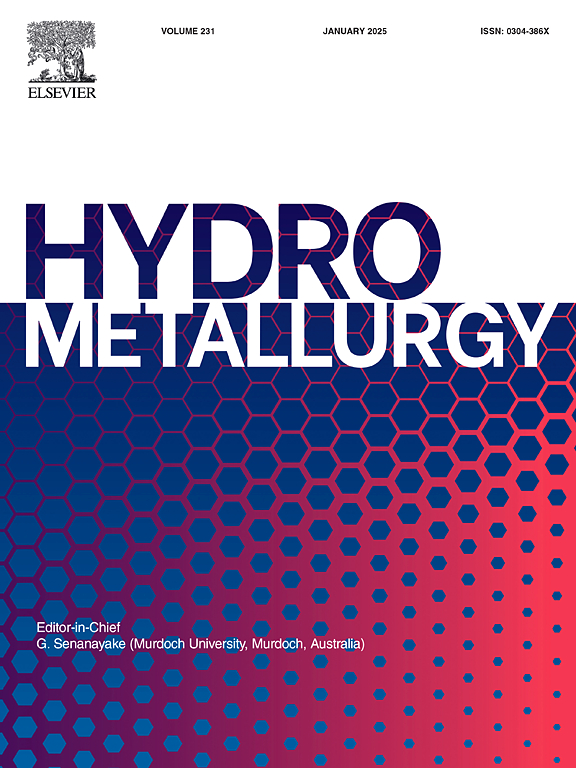K-jarosite precipitation kinetics at low-moderate temperatures: Factors affecting mechanism, formation rates, solid morphology and crystallinity
IF 4.8
2区 材料科学
Q1 METALLURGY & METALLURGICAL ENGINEERING
引用次数: 0
Abstract
Jarosite is a mineral that holds significant importance in the metallurgical industry. For decades, the jarosite process, operating at high temperatures, has been employed to precipitate jarosite and recover Zn. Consequently, many studies have been undertaken to understand the precipitation behavior of jarosite-type compounds. More recently, the development of different hydrometallurgical processes at low temperature led to the need of comprehending the formation of jarosite under such conditions. Therefore, this work investigates the influence of various factors, such as the initial concentration ratio of reactants (K/Fe), agitation, seeding and temperature, on the precipitation rate. Additionally, XRD and SEM analyses of solid products were conducted to assess how those different conditions affect crystallinity and morphology. The experimental results at room temperature demonstrate the existence of three main steps of the precipitation reaction: an instantaneous precipitation, a dissolution and a reprecipitation. Notably, the initial concentration of the reactants and temperature were the main conditions influencing the kinetics of the precipitation and the crystallinity of the solid obtained, while agitation and seeding did not reveal a significant impact. The results and insights obtained from this research are invaluable for improving the understanding of jarosite precipitation at low and moderate temperatures (296 to 343 K) in hydrometallurgical processes.
中低温度下钾黄钾铁矾沉淀动力学:影响机理、形成速率、固体形态和结晶度的因素
黄钾铁矾是一种在冶金工业中具有重要意义的矿物。几十年来,黄铁矾工艺一直被用于高温下的黄铁矾沉淀和锌的回收。因此,人们进行了许多研究来了解黄钾铁矾型化合物的沉淀行为。近年来,由于各种低温湿法冶金工艺的发展,需要了解在这种条件下黄钾铁矾的形成过程。因此,本研究考察了反应物初始浓度比(K/Fe)、搅拌、播种和温度等因素对沉淀速率的影响。此外,对固体产物进行了XRD和SEM分析,以评估不同条件对结晶度和形貌的影响。室温下的实验结果表明,沉淀反应主要有三个步骤:瞬时沉淀、溶解和再沉淀。值得注意的是,反应物的初始浓度和温度是影响沉淀动力学和所得固体结晶度的主要条件,而搅拌和播种没有明显的影响。从本研究中获得的结果和见解对于提高对湿法冶金过程中低温和中温(296至343 K)黄铁矾沉淀的理解是非常宝贵的。
本文章由计算机程序翻译,如有差异,请以英文原文为准。
求助全文
约1分钟内获得全文
求助全文
来源期刊

Hydrometallurgy
工程技术-冶金工程
CiteScore
9.50
自引率
6.40%
发文量
144
审稿时长
3.4 months
期刊介绍:
Hydrometallurgy aims to compile studies on novel processes, process design, chemistry, modelling, control, economics and interfaces between unit operations, and to provide a forum for discussions on case histories and operational difficulties.
Topics covered include: leaching of metal values by chemical reagents or bacterial action at ambient or elevated pressures and temperatures; separation of solids from leach liquors; removal of impurities and recovery of metal values by precipitation, ion exchange, solvent extraction, gaseous reduction, cementation, electro-winning and electro-refining; pre-treatment of ores by roasting or chemical treatments such as halogenation or reduction; recycling of reagents and treatment of effluents.
 求助内容:
求助内容: 应助结果提醒方式:
应助结果提醒方式:


